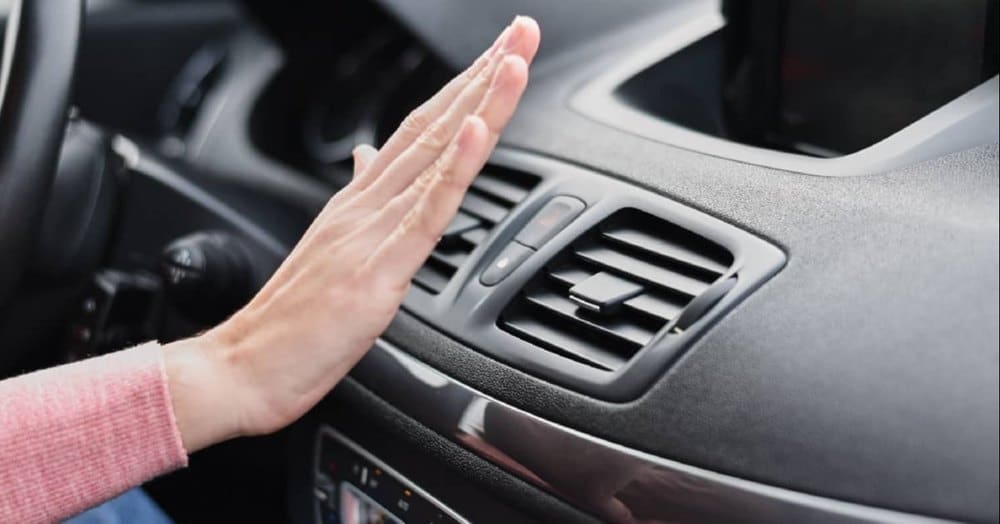AC Pressure Switch Symptoms: Signs of a Failing High-Pressure Switch in Your Car’s AC System
This post may contain affiliate links. That means if you click and buy, we may receive a small commission (at zero cost to you). Please see our full disclosure policy for details.
Air conditioning in a car gives a soothing feeling, especially when you are in traffic in hot weather conditions. Without a working air conditioning system, vehicles like your Ford F-250 or 7.3 Powerstroke suffer from the heat, no matter how much you wind down their car windows.
This is why the AC system and its components, like the AC high-pressure switch, are very important. If the pressure switch fails, there are certain symptoms you will notice. How do you solve the problem of a faulty AC high-pressure switch? This is what this post is all about.
When you have a high-pressure switch within your AC system, you will experience a variety of bad HVAC pressure switch symptoms such as repeated on/off cycling of the compressor, no cooling effect in the car, or a compressor that is not activated. These are the top three signs that your original switch is going bad. You will also learn more about how the system works and other related difficulties.
The AC high-pressure switch plays a crucial role in protecting your vehicle’s air conditioning system by monitoring the pressure within the AC lines. When the pressure becomes too high, the switch signals the compressor to shut off to prevent damage to the system. This protective measure is vital to avoid costly repairs such as compressor failure or leaks in the refrigerant lines.
In addition to the main symptoms, you may also notice other issues like inconsistent cooling, the AC compressor clutch failing to engage, or even electrical problems related to a broken connector. These issues often stem from a malfunctioning or damaged high-pressure switch.
Understanding these symptoms early can save you from extensive damage and expensive repairs. It is also important to note that the AC system works in tandem with other components such as the low-pressure switch, condenser, evaporator, and orifice tube. A problem in any of these parts can sometimes mimic the symptoms of a bad high-pressure switch, so thorough troubleshooting is necessary.
Fortunately, replacing the AC high-pressure switch is often a straightforward and affordable fix. Many owners of vehicles like the Ford F-250 and 7.3 Powerstroke report that the replacement is a direct replacement with an exact fit, making it a simple repair that can restore air conditioning performance quickly. When replacing the AC high-pressure switch, it is advisable to have a shop evacuate the refrigerant to make the process easier.
Moreover, some forum community members dedicated to Ford trucks and Powerstroke engines share their experiences and tips for diagnosing and fixing issues related to the AC high-pressure switch. These discussions often include advice on dealing with broken connectors, corroded terminals, and the importance of using original switches or quality aftermarket parts to ensure long-lasting repairs.
In summary, recognizing the symptoms of a faulty AC high-pressure switch and understanding its role within the AC system can help you maintain your vehicle’s comfort and prevent further damage. Whether you choose to perform a DIY replacement or seek professional help, addressing the problem promptly is key to restoring your air conditioning and enjoying a cool ride, especially during the hot summer months.

How AC System Works?
Before you can understand the symptoms of a failing pressure switch, you have to learn the mechanisms of the air conditioning system as a whole. The auto AC system works on two principles.
The first principle comes from the compressor, a part of the AC system that takes in the gas substance (refrigerant) and is connected to the bay engine area through the small high-pressure lines.
The temperature of the refrigerant increases when compressed, forcing it to move toward the condenser. This is where it turns into liquid, passing through the orifice tube or Schrader valve, then onto the expansion valve.
Once the refrigerant reaches the expansion valve, the pressure drops, turning it into vapor. It then evaporates through the evaporator, which absorbs heat. In the process, the blower supplies cool air through the air gap, helping to restore air conditioning comfort inside the cabin.
A vehicle’s air conditioning system consists of components such as the compressor, condenser, evaporator, expansion valve, blower, and pressure switches. There are two types of switches—high-pressure switch and low-pressure switch—both strategically placed for system protection.
So, what is the function of the AC high-pressure switch, and what happens when it fails? What are the symptoms of a faulty switch? These questions and more are answered below. You’ll also find tips commonly shared across a forum community dedicated to AC troubleshooting.
Air Conditioning Pressure Switch: How it Works
As mentioned earlier, the AC system includes key parts like the compressor, condenser, expansion valves, evaporator, and pressure switches. The compressor compresses refrigerant gas at high pressure, raising its temperature before sending it to the condenser. After conversion to liquid, it moves through the orifice tube or Schrader valve to the expansion valve.
Once the liquid gets to the expansion valve, the pressure drops, and it becomes vapor, moving to the evaporator. Heat is absorbed, and the cooled air is released by the blower into the cabin.
Between these steps, the high-pressure switch monitors the high side switch area (between the compressor and condenser), and the low-pressure switch monitors the low side switch region (between the expansion valve and evaporator). Each switch turns off the compressor if the pressure gets too extreme. A Schrader valve is typically present behind the high-pressure switch, allowing it to be removed without completely evacuating the system.
Excessively high pressure could cause the compressor to burst, potentially damaging the existing switch, clutch, or connector and causing leaks. On the other hand, too-low pressure may exhaust the compressor or leave corroded terminals and damaged wires. That’s why proper maintenance and periodic troubleshooting of these components is key.
Signs of a Bad AC Pressure Switch
Identifying HVAC pressure switch issues early is critical. Here are signs to watch for:
Repeated On/Off of The Car AC
If the AC turns on and off rapidly, even when you haven’t changed the settings, it’s likely that either the high-pressure or low-pressure switch is malfunctioning. Many forums’ top contributors note this as a clear indicator of AC trouble. This rapid cycling occurs because the pressure switch is constantly detecting pressure levels outside the normal range, causing the compressor to engage and disengage repeatedly in an attempt to regulate the system. Not only does this reduce the efficiency of your air conditioning, but it can also lead to premature wear on the compressor and other components. If you notice this symptom, it’s important to inspect the pressure switches and related connectors promptly to avoid further damage and restore proper cooling performance.
No Cooling Effect in the Car
A failing pressure switch disrupts the pressure balance within the AC system, resulting in no cool air output even if the compressor appears to be running. This imbalance prevents the system from effectively circulating refrigerant, which is essential for cooling the air inside your vehicle. If your truck or vehicle isn’t cooling properly despite the compressor operating, it may be a clear indication that the pressure switch is malfunctioning or has failed completely. In such cases, replacing or repairing the switch is necessary to restore proper function and maintain a comfortable cabin temperature.
Compressor Not Activated
If the compressor fails to engage, your AC system cannot function. This might stem from a broken connector, faulty sensor, or a defective pressure switch that isn’t sending the correct input signal. If the high-pressure switch has a faulty connection, the compressor solenoid may not activate, resulting in no AC.
Replacing the Bad AC Pressure Switch
When you experience any of the symptoms above, the best course of action is to diagnose and replace the faulty switch. Whether it’s a low side switch or high side switch, you can often perform a simple repair or complete a direct replacement without special tools. This makes it a convenient fix for many vehicle owners, especially those who prefer DIY repairs.
The process typically involves locating the problematic switch in your vehicle’s AC system, disconnecting the battery to ensure safety, and then carefully removing the existing switch. It’s important to inspect the connector and terminals for any signs of corrosion or damage, as a broken connector can also cause AC issues. In some cases, cleaning or repairing the connector might be sufficient, but often replacing the entire switch provides a more reliable and lasting solution. Replacing the drier at the same time as the high-pressure switch is suggested since the AC system needs to be open.
Once the faulty switch is removed, installing the new one is straightforward. Make sure to use an exact replacement part compatible with your vehicle model, such as the 7.3 Powerstroke AC high pressure switch for Ford trucks. Properly sealing the switch with the correct o-rings and tightening it to the recommended torque ensures a secure fit and prevents refrigerant leaks.
Performing this replacement not only restores the air conditioning system’s functionality but also protects other components like the compressor and condenser from damage due to improper pressure regulation. Additionally, many forum community members dedicated to Ford and Powerstroke vehicles emphasize the value of using original switches or high-quality aftermarket parts to avoid recurring problems.
Overall, replacing a faulty AC pressure switch is a relatively easy and cost-effective repair that can significantly improve your vehicle’s cooling performance and comfort, especially during hot weather. Taking prompt action when symptoms appear helps maintain the longevity of your AC system and prevents more expensive repairs down the line.
Let’s take a look at these simple Do-It-Yourself steps for AC pressure replacement:
- Locate the AC high-pressure switch
- Disconnect the negative battery cable
- Unscrew the faulty switch
- Install and replace it with a new one
Step 1: Locate the AC pressure sensor
Check your Ford or stock vehicle’s engine bay or condenser for the AC pressure sensor. The low-pressure switch is typically larger than the high-pressure switch. Some modifications might require removing the plug, drain lines, or moving aside the harness to get access.
Step 2: Take the sensor off the battery ends
Always disconnect the battery to protect your vehicle’s body, wires, and internal circuits. This also prevents electrical shorts during installation.
Step 3: Unscrew the sensor from the electrical connections
Use a wrench to remove the original switch. Look for signs of corroded terminals, a broken connector, or damaged o-rings. If the connector is damaged, some forum community members recommend using soldering for a stronger connection.
Step 4: Screw and install the new sensor
Make sure the exact replacement matches the original switch. Insert the new part with the right torque and seal it using appropriate o-rings. Some users recommend checking related threads for insert quotes related threads or image gallery guides. Follow any included bb code or insert alignment list instructions for installation.
AC System Troubleshooting
Users are seeking information on diagnosing issues related to the AC system in their vehicles, particularly concerning the high pressure switch and its symptoms.
Replacing the high pressure switch can sometimes require the system to be emptied and vacuumed.
Frequently Asked Questions
Q: How do I check a faulty AC pressure switch?
Watch for rapid cycling, warm cabin temperatures, or poor performance. You can also use a multimeter or pressure gauge. A cold evaporator pipe may also be a clue. Many forums share detailed troubleshooting methods to avoid misdiagnosis.
Q: How does the AC pressure switch work?
The HVAC pressure switch cuts off the compressor when pressure levels are unsafe. It preserves performance and prevents further damage to the AC system.
Q: How much does it cost to replace the AC Pressure Switch?
Depending on the brand, bit size needed, or truck model, you could purchase one for $20–$100. Labor may cost another $30–$150. Users often share sort by price and ease of installation on forum communities. The cost to have the AC system evacuated and recharged can be around $85.
Final Thoughts
I think we already have a proper understanding of how vital the AC high-pressure switch is. They ensure that the car’s air conditioning system works perfectly and also play an essential role in the durability of the entire air conditioning system. So any impediment of these components should be addressed to ensure the system’s reliability.
If you encounter any symptoms similar to those stated above, you should contact an expert technician to diagnose the problem and recommend the proper solution. The proper functioning of your car AC shouldn’t be a whether-or-not matter. Instead, it would help if you took it seriously, especially when summer approaches when the heat is at its peak.
Ignoring issues with the AC high-pressure switch can lead to more severe problems, such as compressor damage or refrigerant leaks, resulting in costly repairs. Regular maintenance checks and timely replacement of faulty switches can help maintain optimal performance and extend the life of your air conditioning system. Additionally, using exact replacement parts and ensuring proper installation will restore air conditioning efficiency and prevent further complications.
For those who enjoy DIY repairs, replacing the AC high-pressure switch can be straightforward with the right tools and precautions. However, if you are unsure or unfamiliar with HVAC pressure switch components, seeking professional assistance is always the safest option. Remember, a well-maintained AC system not only provides comfort but also contributes to the overall health of your vehicle.
- Plastic Fuel Tank Repair: How To Repair
- What Causes Backfire Through Intake?
- Waxing Car Windows: Is It Worth It?
- Transfer Case Fluid: How Often & What Is It?
- Rubbing Compound: What Is It & How To Use
- Gear Shift Stuck: A Complete Guide
- Symptoms of a Failing or Bad Fuel Filter
- P0700 Trouble Code: A Complete Guide
- Engine Misfire Symptoms: What Is It & How To Fix
- Driving With Tire Bulge: Causes & Is It Safe?







